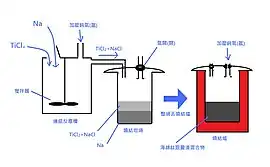亨特法
亨特法(Hunter process)是第一種能夠提煉高純度延性金屬鈦的工業製程。1910年由紐西蘭裔美籍化學家馬修·亞伯特·亨特(Matthew A. Hunter)發現。[1] 該製程使用鈉在700–800 °C的鋼製容器中還原四氯化鈦(TiCl4)得到高純度的鈦。
總反應式如下
- TiCl4 + 4 Na → 4 NaCl + Ti
亨特法從反應可略分為兩步驟
- TiCl4 + 2 Na → 2 TiCl2 + 2 NaCl(第一步驟,連續反應槽反應)
- TiCl2 + 2 Na → Ti + 2 NaCl(第二步驟,坩鍋燒結反應)
由於連續反應槽中的反應為放熱反應,會釋放大量熱量。因此,若能將第一步驟的多餘熱量傳遞給需要較高溫度的第二步驟,將可有效節約能源並提升溫控能力。[3]
在亨特法之前,提煉鈦的製程都只能提供純度不高的鈦材料,通常只能生產氮化鈦。然而自從1940年用鎂還原四氯化鈦的克羅爾法出現之後,亨特法的經濟效益已然相形見絀而被日漸取代。 [4]
參考文獻
- M. A. Hunter "Metallic Titanium" J. Am. Chem. Soc. 1910, pp 330–336. doi:10.1021/ja01921a006
- William F. Smith著,《Structure And Properties Of Engineering Alloys》,第434頁
- William F. Smith著,《Structure And Properties Of Engineering Alloys》,第435頁
- Heinz Sibum, Volker Günther, Oskar Roidl, Fathi Habashi, Hans Uwe Wolf, "Titanium, Titanium Alloys, and Titanium Compounds" in Ullmann's Encyclopedia of Industrial Chemistry 2005, Wiley-VCH, Weinheim. doi:10.1002/14356007.a27 095
參考書目
- William F. Smith著,《Structure And Properties Of Engineering Alloys》國際版第二版,紐約:McGraw-Hill Education,1993年,ISBN 978-0-07-112829-2.
This article is issued from Wikipedia. The text is licensed under Creative Commons - Attribution - Sharealike. Additional terms may apply for the media files.
